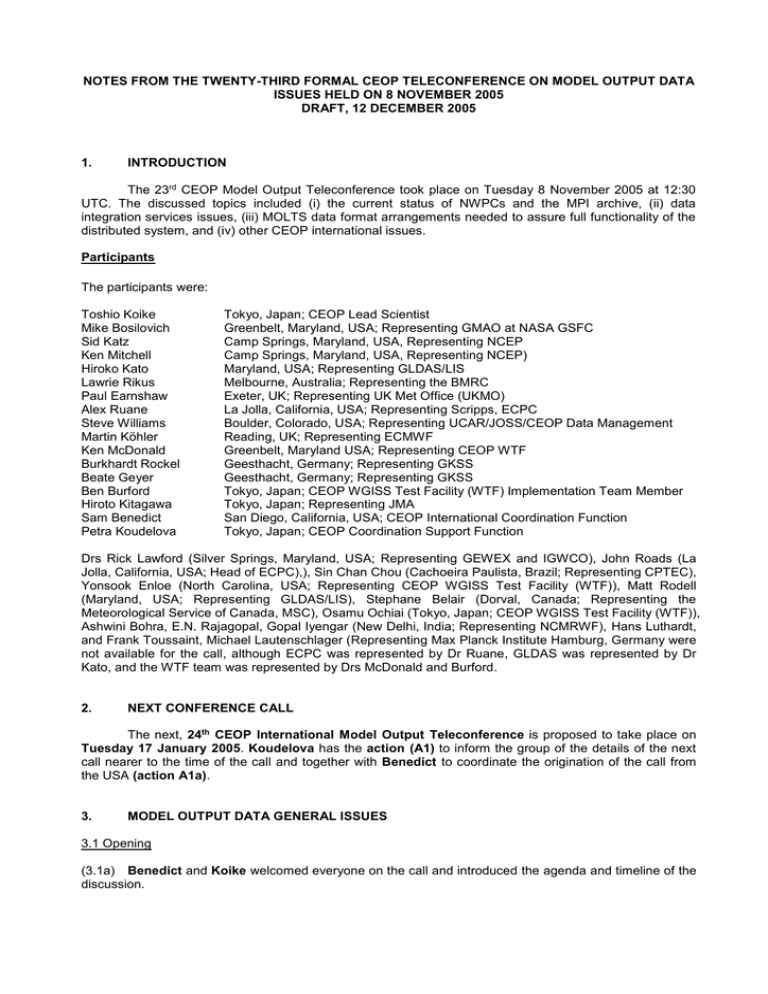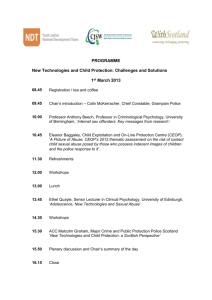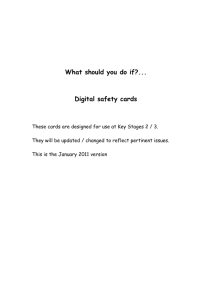NOTES FROM THE TWENTY-THIRD FORMAL CEOP TELECONFERENCE ON MODEL OUTPUT... ISSUES HELD ON 8 NOVEMBER 2005
advertisement

NOTES FROM THE TWENTY-THIRD FORMAL CEOP TELECONFERENCE ON MODEL OUTPUT DATA ISSUES HELD ON 8 NOVEMBER 2005 DRAFT, 12 DECEMBER 2005 1. INTRODUCTION The 23rd CEOP Model Output Teleconference took place on Tuesday 8 November 2005 at 12:30 UTC. The discussed topics included (i) the current status of NWPCs and the MPI archive, (ii) data integration services issues, (iii) MOLTS data format arrangements needed to assure full functionality of the distributed system, and (iv) other CEOP international issues. Participants The participants were: Toshio Koike Mike Bosilovich Sid Katz Ken Mitchell Hiroko Kato Lawrie Rikus Paul Earnshaw Alex Ruane Steve Williams Martin Köhler Ken McDonald Burkhardt Rockel Beate Geyer Ben Burford Hiroto Kitagawa Sam Benedict Petra Koudelova Tokyo, Japan; CEOP Lead Scientist Greenbelt, Maryland, USA; Representing GMAO at NASA GSFC Camp Springs, Maryland, USA, Representing NCEP Camp Springs, Maryland, USA, Representing NCEP) Maryland, USA; Representing GLDAS/LIS Melbourne, Australia; Representing the BMRC Exeter, UK; Representing UK Met Office (UKMO) La Jolla, California, USA; Representing Scripps, ECPC Boulder, Colorado, USA; Representing UCAR/JOSS/CEOP Data Management Reading, UK; Representing ECMWF Greenbelt, Maryland USA; Representing CEOP WTF Geesthacht, Germany; Representing GKSS Geesthacht, Germany; Representing GKSS Tokyo, Japan; CEOP WGISS Test Facility (WTF) Implementation Team Member Tokyo, Japan; Representing JMA San Diego, California, USA; CEOP International Coordination Function Tokyo, Japan; CEOP Coordination Support Function Drs Rick Lawford (Silver Springs, Maryland, USA; Representing GEWEX and IGWCO), John Roads (La Jolla, California, USA; Head of ECPC),), Sin Chan Chou (Cachoeira Paulista, Brazil; Representing CPTEC), Yonsook Enloe (North Carolina, USA; Representing CEOP WGISS Test Facility (WTF)), Matt Rodell (Maryland, USA; Representing GLDAS/LIS), Stephane Belair (Dorval, Canada; Representing the Meteorological Service of Canada, MSC), Osamu Ochiai (Tokyo, Japan; CEOP WGISS Test Facility (WTF)), Ashwini Bohra, E.N. Rajagopal, Gopal Iyengar (New Delhi, India; Representing NCMRWF), Hans Luthardt, and Frank Toussaint, Michael Lautenschlager (Representing Max Planck Institute Hamburg, Germany were not available for the call, although ECPC was represented by Dr Ruane, GLDAS was represented by Dr Kato, and the WTF team was represented by Drs McDonald and Burford. 2. NEXT CONFERENCE CALL The next, 24th CEOP International Model Output Teleconference is proposed to take place on Tuesday 17 January 2005. Koudelova has the action (A1) to inform the group of the details of the next call nearer to the time of the call and together with Benedict to coordinate the origination of the call from the USA (action A1a). 3. MODEL OUTPUT DATA GENERAL ISSUES 3.1 Opening (3.1a) Benedict and Koike welcomed everyone on the call and introduced the agenda and timeline of the discussion. (3.1b) Rockel introduced Dr Beate Geyer, who is working with him on the Inter-CSEs Transferability Study at GKSS, Geesthacht, Germany and who has developed a conversion tool for converting the CEOP MOLTS data from the native to the CF compliant NetCDF format. 3.2 MPI status – written report (3.2a) Luthardt reported in writing that new data from ECPC SFM-Model were on the way to be included into the data base, which would increase the size of data stored there to about 4 Terabyte in total. (3.2b) The MPI team was working with Dr Belair on the viable means of data transfer from the MSC data base to the MPI archive. (3.2c) The transfer of the GLDAS MOLTS data has been initiated and a first set of data arrived to the MPI archive. The discussion was underway on the conversion of the GLDAS data to the NetCDF CF compatible format. (3.2d) Luthardt further reported that a sample of data (four MOLTS sets) had been included into the ORACLE data base in a form that permitted direct access via http string and thus could be accessed by the WTF-CEOP distributed data integration system. There were still certain minor issues and the MPI team was resolving them in cooperation with the WTF-CEOP group. (3.2e) The MPI team was discussing with the GKSS group (represented by Drs Rockel and Geyer) and Dr Rikus the most effective way to convert the MOLTS data into the NetCDF CF compatible format. More details on this issue are provided below in section 3.3. 3.3 MOLTS data format issues (3.3a) Benedict opened the discussion on the MOLTS data format conversion issue and reiterated the outcomes and action items that had resulted from the last teleconference held on 20 September. He pointed out that it had been agreed that the CEOP MOLTS data would be converted into the NetCDF CF (Climate and Forecast) compliant format in order to unify the nomenclature of the data variables to facilitate intercomparison studies and that the link to the CF convention website had been posted on the NCAR (UCAR) web page (http://www.cgd.ucar.edu/cms/eaton/cf-metadata/index.html). (3.3b) Rikus voiced that the current version of his conversion program did not include the CF convention and in addition, if more time series were required to be stored, the program produced a separate file for each time series, while the tool developed by Beate Geyer kept all the time series in one file, which was more convenient. Therefore, based on the discussion among Rikus, the MPI team and the GKSS team, it was decided that the tool developed by Beate Geyer would be used to convert the CEOP MOLTS data sets archived at MPI. Rockel reiterated that their team had already converted most of the MOLTS data currently available at the MPI archive into the CF compliant NetCDF format for the purpose of the transferability study and voiced that the converted data would be sent to the MPI archive, as it was agreed to through the discussion between the GKSS and MPI groups. (3.3c) Rockel reported that they had checked the data sets of all of the contributing centers and identified the variables, for which CF standard names did not exist. Rockel accepted the action (A2) to send the list of these variables to the NWPCs spokespersons and the NWPCs spokespersons including Bosilovich, Mitchell, Katz, Rodell, Kato, Kitagawa, Bohra/Rajagopal/Iyengar, Earnshaw, Chou, Rikus, Ruane, Köhler, and Belair were asked to undertake the action (A2a) to go through the lists for their respective centers and select the variables, for which they deem it would be desirable to ask for standardization under the CF convention. Rockel felt that it was not necessary to standardize all variables because some of them were unique for certain centers and probably would not be used by others. In this respect, Ruane mentioned that the ECPC output files contained more than 100 variables such as flux divergences and column energy variables, for which the CF standard names had not been defined yet, but many of them were very specific for the ECPC output and therefore their standardization would not be necessary. Ruane voiced that he would select a basic set of the variables that he feels should be standardized and would contact the CF convention group and Geyer with proposal of the new standard names. (3.3d) Rockel further mentioned that Geyer had also used her program to convert reference site data from the sites, for which complete EOP-3 and EOP-4 datasets were available at the NCAR archive, into the same, CF compliant NetCDF format to facilitate the comparisons of regional and global model outputs with corresponding in-situ data carried out within the scope of the transferability study. It was suggested that the in-situ data in the CF compliant NetCDF format be included in the reference site data base and Williams took the action A3 to ascertain whether and how it would be possible to add these data sets in the Central Data Archive at NCAR. Rockel agreed to send a sample of the in-situ data in the NetCDF format to Williams and also to send samples of the converted model data sets to the respective centers (action A3a). (3.3e) Geyer pointed out that the current version of her program was not commented and thus not very user-friendly and she accepted the action (A4) to continue to do the actual conversion of further data that would be arriving to the MPI archive. (3.3f) Everyone on the call greatly appreciated the effort Beate Geyer has been devoting to the CEOP data conversion and acknowledged the excellent work she has accomplished up to now since it represents a major contribution for resolving this issue. 3.4 Reference site data update and vegetation and soil characteristics metadata (3.4a) Williams reported that the ARM SGP and the ARM TWP data were complete through the EOP-4 period and available on-line. The Cabauw data sets also were very close to completion with only the flux data for the second half of EOP-4 missing. (3.4b) Benedict informed the participants that at the Asian Water Cycle Symposium new quality control tools were introduced that had been developed by the University of Tokyo team in order to facilitate data QC process for the CAMP site managers. The tools are available on-line and accessible through a userfriendly interface to registered users. It has been agreed that the system would be opened to other CEOP sites to help the managers with the their QC procedure and thus expedite the process of data submission to the CEOP on-line data base. For more information about the system the participants should contact Katsunori Tamagawa at the University of Tokyo (tamagawa@hydra.t.u-tokyo.ac.jp). 4. SATELLITE DATA AND DATA INTEGRATION ISSUES 4.1 Satellite data (4.1a) Koike reiterated that a list of CEOP requirements for the satellite data was drafted and sent to NESDIS, NASA, and ESA in order to complement the data sets provided by JAXA. The result will be a comprehensive water cycle data set that will be available through the integrated CEOP system facilitating access to the data for users and thus enabling maximum use of these data. (4.1b) Koike reported that the CEOS plenary meeting would be held in London on 15 November 2005 and that CEOP was invited to provide updated status and report on plans for Phase 2 in terms of satellite data. He mentioned that he would represent CEOP on this meeting and would also ask the space agencies to support the current and planned CEOP activities. 4.2 WTF-CEOP and Distributed Data Integration Services (4.2a) McDonald advised the group that the proposal they had submitted in order to assure adequate support to build a system through which the NASA satellite data would be accessible to the CEOP community was successful. McDonald mentioned that there were certain comments that would need to be addressed through the upcoming negotiation process but he felt that the support would be maintained. He also voiced that the partnership with CEOP was very positively viewed and acknowledged the special efforts of those who had contributed to the proposal document. (4.2b) Burford reported that the WTF-CEOP Distributed Data Integration System had been working smoothly without any reported issues for several weeks and that all of in-situ data currently available at the Central Data Archive (CDA) at NCAR were accessible on-line through the system. Burford advised the group that the issues associated with the access to the CEOP Satellite Data Integration Center (CSDIC) at UT had been solved and first samples of satellite data were accessible through the system. He voiced that further volumes of data would be included soon. Burford also reported that all of the details on the WTFCEOP/MPI archive interface had been agreed on and the MPI team was working on their implementation. He mentioned that a sample of the MOLTS data was accessible through the new interface and more data sets would be available as soon as they would be ingested into the ORACLE data base at MPI. Burford acknowledged the MPI team for their outstanding effort to set up the interface to be uniform with other CEOP archives and thus the most efficient for the system. (4.2c) Burford pointed out that they were focusing on the EOP-3 and EOP-4 data because the EOP-1 insitu data were archived in a different format and not put on a DODS server and thus it would require additional developments on the system and due to the time gap between EOP-1 and EOP-3 a series of issues would have to be addressed. The issue of the EOP-1 and EOP-2 data will be discussed later. (4.2d) Burford further reported that they had attended the WGISS Group on Calibration and Validation (WGCV) conference call on 31 October and the WGCV team had expressed their interest to have access to several CEOP reference sites data and would further discuss this matter with the WTF-CEOP. In addition, Burford mentioned that the distributed system had been successfully demonstrated at the Asian Water Cycle Symposium in Tokyo (see section 6). (4.2e) Burford also reiterated the future plans of the JAXA RESTEC WTF-CEOP team for the next three years. The team will focus on adding further data searching, discovery, access, and integration functions to expand the WTF-CEOP distributed data integration system and enhance its synthesis capabilities. The plan is to also include the non-CEOP data on the system based on the interests of the system users. 5. CURRENT STATUS OF NWPCs 5.1 BMRC by Lawrie Rikus (5.1a) Rikus reported that their work on the new version of their model was advancing and might be accomplished soon. Changes to the BMRC organizational structure are currently underway and Rikus will keep the group informed about the implications of any changes that might have an effect on their contribution to CEOP. 5.2 GKSS by Burkhardt Rockel (5.2a) Rockel reported that currently seven regional climate models were involved in the Inter-CSEs Transferability Study (ICTS). He mentioned that the models were run using the NCEP reanalysis 2 data as driving fields and all models except the RSM were still in the simulation process that should finish by the end of the year. The results of the RSM model simulation, which has been completed for the whole 5-year period from January 2000 – December 2004, has been uploaded to the MPI archive and the results of the other models may appear in the archive in mid-January 2006. 5.3 GLDAS by Hiroko Kato (5.3a) Kato reported that the GLDAS team had submitted the MOLTS data to the MPI archive but based on the analysis of the results they had decided to reprocess certain set(s) of the MOTLS data. The reprocessing has been accomplished and Kato will send the new data sets to the MPI archive in the near future. (5.3b) Kato further reported that they still needed to submit the MOTLS metadata and inquired about the proper form of such documentation. Mitchell explained that a table had been prepared for the NWPCs to fill out the required information that is available at the NCAR web pages. Williams took the action (A5) to send the link to this table to Kato. (5.3c) Kato also mentioned that she was communicating with Geyer the issues related to the conversion of the GLDAS MOLTS data into the CF compliant NetCDF format. 5.4 NCEP by Ken Mitchell and Sid Katz (5.4a) Mitchell reported that the metadata documentation had been updated to address the changes associated with the modifications to the NCEP modeling system such as change of grid point locations as well as grid characteristics with respect to the reference sites due to the higher spatial resolution and the change of the number of output values due to the increased number of the soil layers. The updated documentation will be sent to Dr Williams to be posted on the CEOP Model Output group page. 5.5 ECMWF by Martin Köhler (5.5a) Köhler reported that he had been informed by Viterbo that the ECMWF gridded global fields from the ERA-40 reanalysis had been submitted for the period available, i.e.1 July 2001 – 31 August 2002 but the ECMWF had not submitted any MOLTS data yet. Köhler mentioned that accordingly, the group would focus on the MOTLS data in the coming months and that they would provide the MOLTS from the operational system through the whole requested period up to now but only the same period of the ERA-40 MOLTS as for the gridded output. He also pointed out that the new reanalysis by the updated model would be carried out that would start in early 2006 and finish in 2007 and the output of this reanalysis would also be provided to the CEOP data base, when available. (5.5b) Köhler voiced that he would contact the MPI group to inquire about the details of the submission process and would follow with submitting the data in the near future. Subsequently, Köhler submitted the MOLTS from the operational system through December 2004 in the ascii format and also provided the table of variables with corresponding CF standard names. 5.6 UK Met Office by Paul Earnshaw (5.6a) Earnshaw reported that the team was fully engaged in the model resolution upgrade that was in the final phase of testing. (5.6b) Earnshaw mentioned that he had communicated with Geyer the matter of the UKMO MOLTS data conversion into the CF compliant NetCDF format and it was agreed that the data would continue to be sent to the MPI archive in the native, i.e. ascii, format and Geyer would do the conversion as mentioned above in section 3.3. 5.7 GMAO by Mike Bosilovich (5.7a) Bosilovich expressed his appreciation of Geyer’s effort on data conversion and voiced that they would be very glad to receive their converted data to double-check them and also to use them for validation studies of their model. (5.7b) Bosilovich mentioned that he was downloading the gridded data of all models for the EOP-3 and EOP-4 period from the MPI data base and that the transfer rate was about 30 GB per a week. He pointed out that it indicated that there was a need to expedite the downloading of the gridded data, which could be achieved by decomposing the large files to individual variables. It was agreed that this issue should be discussed and addressed soon. (5.7c) Bosilovich further reported that they were installing a new server to increase data storage capacity as a part of the CEOP model intercomparison project that had been accepted for funding by NASA Modeling Analysis and Prediction (MAP) program. Bosilovich mentioned that he was also investigating new software provided by WebMap services that include visualization capabilities for model data and thus would be helpful for the model intercomparison project. He will inform the group about his findings on this matter. 5.8 ECPC by Alex Ruane (5.8a) Ruane reported that the ECPC team had submitted the gridded global output as well as MOLTS data of both their models for the entire period of CEOP Phase 1 to the MPI center and were currently working on the updated variable tables. 5.9 JMA by Hiroto Kitagawa (5.9a) Kitagawa reported that the JMA team was analyzing their MOTLS through comparison with the insitu data and that they were working on development of the new land surface model that would be incorporated in the operational global model of JMA. (5.9b) Kitagawa also mentioned that they were planning to submit a paper to the special CEOP issue of JMSJ that would be concerned with the evaluation of the new LSM using the reference site data. 6. OTHER ISSUES (6a) It was reiterated that The Fifth CEOP Implementation Planning Meeting would be held jointly with the IGOS-P IGWCO theme implementation team in Paris, France, Sunday 26 February – Friday 3 March 2006 and the participants were asked to visit the meeting Home Page available at: http://copes.ipsl.jussieu.fr/Workshops/CEOP_IGWCO/index.html, which is being regularly updated and contains the brief agenda of the meeting and detailed information about the venue and hotels. The participants were also asked to advise Sam Benedict (sam.benedict@gewex.org) and Petra Koudelova (petra@hydra.t.u-tokyo.ac.jp) whether or not they plan to attend the meeting. (6b) Koike mentioned that the CEOP Phase 2 Implementation/Science Plan would be further commented on by the GEWEX SSG at the SSG meeting in Dakar, Senegal, 9 – 13 January 2006. The prospective comments will be addressed in the pre-final draft of the Plan that will be sent to the WCRP JSC for their review before the JSC meeting in March. Koike pointed out that one of the expected outcomes of the CEOP Meeting in Paris would be to end with a set of clearly defined specific implementation steps that can be used in the final refinement of the draft of the Plan. (6c) Koike reported that the Asian Water Cycle Symposium was be held in Tokyo, 2 – 4 November 2005 as the first step toward establishment of a regional GEOSS Water initiative in Asia that is aiming at developing a sustainable scheme for water cycle data collecting, sharing, exchanging, and management in compliance with the main objectives of the GEO Committee on Architecture and Data, namely Convergence of Observation, Interoperability, and Data Management. The meeting was co-hosted by GEO, JAXA, JAMSTEC, and UT and involved more than 140 participants from 19 countries including scientists, water management experts, governmental and Non-governmental Organization (NGO) representatives. Koike mentioned that the meeting had been very productive and led to the establishment of the International Task Team that will follow up with the actions identified as the “next steps” and agreed to at the time of the summary session of the meeting. Koike felt that CEOP had been very well accepted as a prototype of a data integrated system that could be applied at the regional level in Asia and that close collaboration might be initiated between CEOP and new reference sites for Phase 2. (6d) Bosilovich advised the participants that he would participate in the International Workshop on Land Surface Models and their Applications (http://www.icces.net/ctwf2005/home.htm) organized by the Chinese Academy of Sciences (CAS), the Third World Academy of Sciences (TWAS), and WMO in Zhuhai, Guangdong, China, 15 – 18 November 2005, and that Dr. Kun Yang from the University of Tokyo would also attend this event. Koike emphasized that it was a high-level meeting and thus Bosilovich’s and Yang’s participation was very important for CEOP and appreciated the effort Bosilovich and Yang devoted to this event. (6e) Koudelova reiterated that a special issue of the Journal of Meteorological Society Japan (JMSJ) dedicated to CEOP would be published in early 2007 and introduced the funding support policy. It has been decided that financial support will be provided by the CEOP Tokyo Office that will cover all charges associated with publication of papers including a charge for one color page. However, the author will be requested to take the responsibility for charges associated with additional color pages if the paper contains more color figures than can be accommodated on a single color page. The manuscript preparation and submission guideline is available at: http://wwwsoc.nii.ac.jp/msj/JMSJ/JMSJ_contrib.html. The due date for manuscript submission was subsequently postponed to 31 January 2006. The manuscripts for this special issue should be sent directly to: Dr. Toshio KOIKE Department of Civil Engineering, School of Engineering, The University of Tokyo 7-3-1 Hongo, Bunkyo-ku Tokyo 113-8656, Japan Koike advised the group that he would serve as the chair of a special editorial board and would work with the JMSJ editors on setting up the board. He pointed out that he would wish to also involve experts from the CEOP community in the editorial board and thus asked the participants for their kind cooperation if they receive a formal letter requesting their participation. (6f) Koudelova advised the group that the next, ninth, issue of the CEOP Newsletter was planned be published in early February 2006. This volume will be dedicated to the achievements and current status of the CEOP observation and data component and thus will complement the previous editions that were focused on the results achieved by the science component of CEOP. The proposed content of the Newsletter No. 9 includes a commentary article by the Chair of the GEWEX Science Steering Group, Prof. Soroosh Sorooshian; an article summarizing the Asian Water Cycle Symposium held in Tokyo, November 2005 by Sam Benedict; and five technical articles providing an overview of the achievements of the CEOP data component up to the present. The preliminary layout of the technical articles is as follows: (i) (ii) (iii) (iv) (v) Status of the in-situ archive (~2 pages) – Steve Williams, Scot Loehrer Status of the model output archive (~1.5 page) – Michael Lautenschlager, Hans Luthardt, Frank Toussaint Status of the satellite data archive (~ 1 page) – Toshio Koike Centralized Data Integration System (~ 0.5 page) – Toshio Koike Distributed Data Integration System (~1 page) – Osamu Ochiai, Ben Burford, Ken McDonald, Yonsook Enloe The persons highlighted above were asked to take the action (A6) to draft the respective articles and submit them to Koudelova (petra@hydra.t.u-tokyo.ac.jp) and Benedict (sam.benedict@gewex.org) at their earliest convenience but no later than 31 December 2006. 7. CLOSING Koike acknowledged the participants for attending the call and providing their valuable contributions, comments and suggestions. The call was adjourned at 14:00 UTC.






